Leilira Blade

ABORIGINAL ARTEFACTS BANKA BANKA HOTEL, 2013.
Aboriginal Artefacts Banka Banka Hotel, 2013. Note the Leilira blade attached to the spear. These stone artefacts are one of the main items in the winnun trade cycle. I have argued that giving these blades to tourists, as exemplified here, is one way of deliberately disposing of them. Photograph by Kate Rogers.
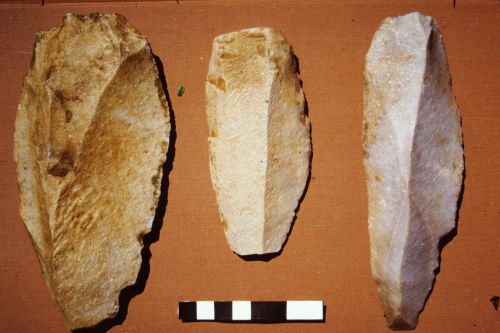
LEILIRA BLADES USED IN THE WINNUN CYCLE
Leilira blades used in the winnun trade and exchange cycle. The blades are an important component of the Pelican Dreaming history.
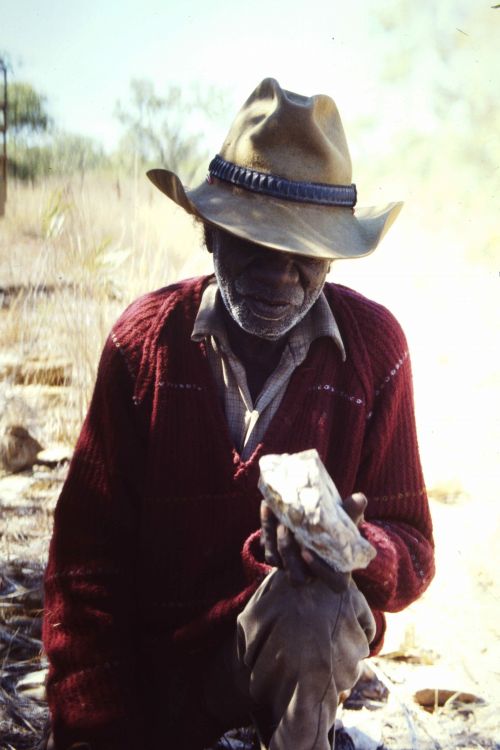
LEILIRA BLADE MANUFACTURE: ABBY THOMAS
Leilira blade manufacture: Abby Thomas. This photograph was taken in 1986 at a blade quarry called Ipitjirintja. This is a pelican Dreaming site that also has associations with the fly Dreaming.
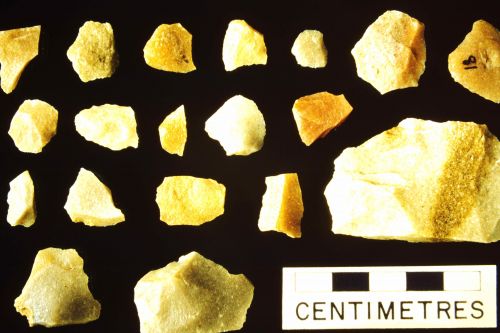
LEILIRA BLADE SEGMENTS
Leilira blade segments caused by the deliberate snapping of the blades as part of winnun. Important Dreaming histories are associated with the various trade goods. These stories travel with the goods as a part of the trade cycle called Winnun. Leilira blades are closely associated with the Pelican Dreaming. In the Pelican Dreaming history, one blade on top of the other forms the pelican beak.

LEILIRA BLADE CORE
This is the parent rock that the Leilira blades are made from. It is known as a core. You can see the negative scars where the blades were removed by a method called direct percussion.
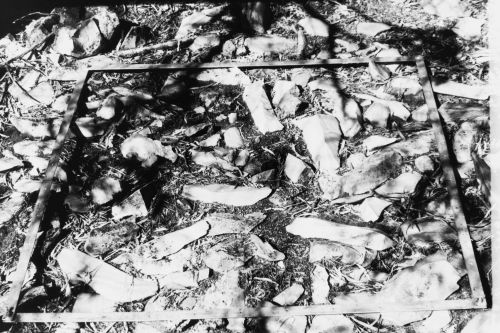
LEILIRA BLADE QUARRY
Leilira blade quarry called Kankiritja (or pelican landing place). Important Dreaming histories are associated with the various trade goods. These stories travel with the goods as a part of the trade cycle called Winnun. Leilira blades are closely associated with the Pelican Dreaming. In the Pelican Dreaming history, one blade on top of the other forms the pelican beak.

LEILIRA BLADES
Leilira blades. Note one has a beeswax handle. These blades are traded in the winnun cycle. Important Dreaming histories are associated with the various trade goods. These stories travel with the goods as a part of the trade cycle called winnun. Leilira blades are closely associated with the Pelican Dreaming. In the Pelican Dreaming history, one blade on top of the other forms the pelican beak.

NUGGETT COLLINS AT YIPITJIRINTJA LEILIRA BLADE QUARRY.
Nuggett Collins at Yipitjirintja Leilira blade quarry, 1985.

LEILIRA BLADE
Leilira blade. Important Dreaming histories are associated with the various trade goods. These stories travel with the goods as a part of the trade cycle called Winnun. Leilira blades are closely associated with the Pelican Dreaming. In the Pelican Dreaming history, one blade on top of the other forms the pelican beak.

LEILIRA BLADE SEGMENT
Leilira blade segment resulting from the deliberate snapping of the blades as part of the winnun exchange system.

MAKING LEILIRA BLADES
Larry Brandy and Nuggett Collins burning rock to make Leilira blades, 1986. This is a Pelican Dreaming site called Kankiritja.
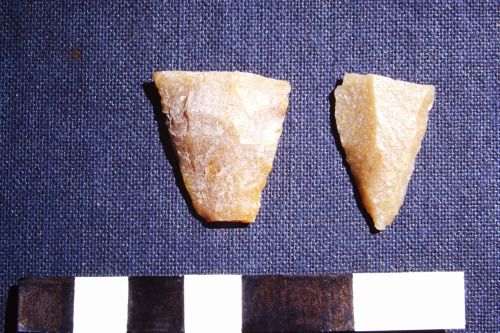
LEILIRA BLADE SEGMENTS
Leilira blade segments caused by the deliberate snapping of the blades as part of the winnun exchange cycle.

MAKING LEILIRA BLADES
Larry Brandy and Nuggett Collins burning rock to make Leilira blades, 1986. The rock is burnt to help remove natural micro-fractures prior to blade manufacture. This is an important Pelican Dreaming site and the firing of the rock is part of the Pelican History for this place.

ABBY THOMAS
Abby Thomas making a Leilira blade near Newcastle Waters, 1986. Important Dreaming histories are associated with the various trade goods. These stories travel with the goods as a part of the trade cycle called Winnun. Leilira blades are closely associated with the Pelican Dreaming. In the pelican Dreaming history, one blade on top of the other forms the pelican beak.
Google Maps Location

ABORIGINAL ARTEFACTS BANKA BANKA HOTEL, 2013.
Aboriginal Artefacts Banka Banka Hotel, 2013. Note the Leilira blade attached to the spear. These stone artefacts are one of the main items in the winnun trade cycle. I have argued that giving these blades to tourists, as exemplified here, is one way of deliberately disposing of them. Photograph by Kate Rogers.
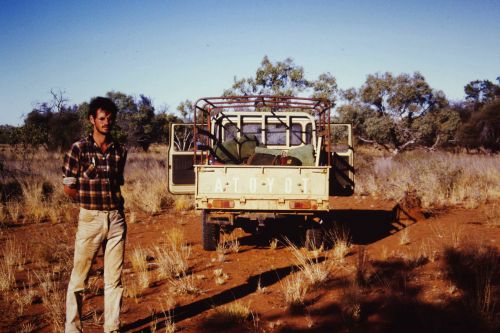
ROB PATON 1985
Rob Paton 1985 recording a Leilira blade quarry.

LEILIRA BLADES USED IN THE WINNUN CYCLE
Leilira blades used in the winnun trade and exchange cycle. The blades are an important component of the Pelican Dreaming history.

LEILIRA BLADE MANUFACTURE: ABBY THOMAS
Leilira blade manufacture: Abby Thomas. This photograph was taken in 1986 at a blade quarry called Ipitjirintja. This is a pelican Dreaming site that also has associations with the fly Dreaming.

LEILIRA BLADE SEGMENTS
Leilira blade segments caused by the deliberate snapping of the blades as part of winnun. Important Dreaming histories are associated with the various trade goods. These stories travel with the goods as a part of the trade cycle called Winnun. Leilira blades are closely associated with the Pelican Dreaming. In the Pelican Dreaming history, one blade on top of the other forms the pelican beak.

LEILIRA BLADE CORE
This is the parent rock that the Leilira blades are made from. It is known as a core. You can see the negative scars where the blades were removed by a method called direct percussion.

LEILIRA BLADE QUARRY
Leilira blade quarry called Kankiritja (or pelican landing place). Important Dreaming histories are associated with the various trade goods. These stories travel with the goods as a part of the trade cycle called Winnun. Leilira blades are closely associated with the Pelican Dreaming. In the Pelican Dreaming history, one blade on top of the other forms the pelican beak.

LEILIRA BLADES
Leilira blades. Note one has a beeswax handle. These blades are traded in the winnun cycle. Important Dreaming histories are associated with the various trade goods. These stories travel with the goods as a part of the trade cycle called winnun. Leilira blades are closely associated with the Pelican Dreaming. In the Pelican Dreaming history, one blade on top of the other forms the pelican beak.

NUGGETT COLLINS AT YIPITJIRINTJA LEILIRA BLADE QUARRY.
Nuggett Collins at Yipitjirintja Leilira blade quarry, 1985.

LEILIRA BLADE
Leilira blade. Important Dreaming histories are associated with the various trade goods. These stories travel with the goods as a part of the trade cycle called Winnun. Leilira blades are closely associated with the Pelican Dreaming. In the Pelican Dreaming history, one blade on top of the other forms the pelican beak.

LEILIRA BLADE SEGMENT
Leilira blade segment resulting from the deliberate snapping of the blades as part of the winnun exchange system.

MAKING LEILIRA BLADES
Larry Brandy and Nuggett Collins burning rock to make Leilira blades, 1986. This is a Pelican Dreaming site called Kankiritja.

LEILIRA BLADE SEGMENTS
Leilira blade segments caused by the deliberate snapping of the blades as part of the winnun exchange cycle.

MAKING LEILIRA BLADES
Larry Brandy and Nuggett Collins burning rock to make Leilira blades, 1986. The rock is burnt to help remove natural micro-fractures prior to blade manufacture. This is an important Pelican Dreaming site and the firing of the rock is part of the Pelican History for this place.

ABBY THOMAS
Abby Thomas making a Leilira blade near Newcastle Waters, 1986. Important Dreaming histories are associated with the various trade goods. These stories travel with the goods as a part of the trade cycle called Winnun. Leilira blades are closely associated with the Pelican Dreaming. In the pelican Dreaming history, one blade on top of the other forms the pelican beak.

MAKING LEILIRA BLADES
Larry Brandy and Nuggett Collins burning rock to make Leilira blades, 1986. The rock is burnt to enhance its flaking qualities through the removal of natural micro-fractures. This is an important Pelican Dreaming site called Ipitjirintja (which is also a fly Dreaming).

LEILIRA BLADE QUARRY
Detail of Leilira Blade quarry called Kankiritja, near Newcastle Waters, 1986. The blades from these quarries are major items of trade in the winnun exchange ceremonies.